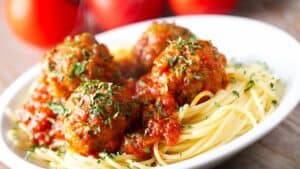If you eat expired dry pasta, the flavor and texture may not be as satisfying as when it’s fresh. While the chances of dry pasta spoiling are low, exposure to moisture or contaminants can lead to spoilage.
Moreover, consuming contaminated dry pasta can potentially cause foodborne illness, resulting in unpleasant symptoms like diarrhea, nausea, cramps, and vomiting. However, it is generally safe to eat dry pasta that has passed its expiration date if it looks and smells normal after cooking a small portion.
So, stick around as we uncover everything you need to know about eating expired dry pasta. Whether you’re a pasta enthusiast trying to salvage an old package or simply curious about the potential risks, this blog post aims to provide you with the essential information you seek. Let’s embark on this culinary exploration together!
The Potential Risks of Eating Expired Dry Pasta
Expired dry pasta may not be risky to eat in terms of food safety, but it can lead to some potential risks if not handled or stored properly. Here are the main risks associated with consuming expired dry pasta:
Contamination: One of the biggest risks of eating expired dry pasta is the potential for contamination. If the pasta is improperly stored or handled, it can become a breeding ground for bacteria, such as Bacillus cereus. This foodborne pathogen can cause gastrointestinal issues like diarrhea, nausea, cramps, and vomiting.
To minimize the risk of contamination, it is crucial to store dry pasta in an airtight container made of plastic or glass. This will help prevent pests from getting into the pasta and also protect it from any external contaminants. It is also important to check for any signs of pantry bugs in or on the packaging.
Loss of flavor and texture: While it may be technically safe to eat dried pasta past its expiration date, the main drawback is that it can lose its flavor and texture over time. As pasta ages, it may become stale, brittle, or clumpy. Consuming expired dry pasta can lead to a less enjoyable eating experience and may not provide the expected taste and texture.
Spoilage indicators: To determine if dry pasta has gone bad, you can look for certain signs of spoilage. Discoloration, mold growth, and bad smells are clear indicators that the pasta has spoiled and should not be consumed. Additionally, if the pasta appears cracked or brittle, it is another sign that it has passed its prime.
Identifying Spoiled Dry Pasta
Dry pasta is a pantry staple that usually doesn’t go bad the same way fresh produce or meat does. However, it can still spoil and pose a risk of foodborne illness if consumed when expired or stored improperly. Here are some tips to help you identify spoiled dry pasta:
- Visual cues: Look for any discoloration, mold growth, or unusual spots on the pasta. These are signs of spoilage.
- Smell test: Take a whiff of the pasta. If it emits a bad or off-putting odor, it’s a clear indicator that it has gone bad.
- Check the expiration date: Although dry pasta can last for a few years, it’s best to use it within two years of the “best by” date. If the pasta is past its expiration date, it’s better to discard it.
- Cook a small amount: If you want to be sure, cook a small portion of the pasta. If it doesn’t cook up normally, such as becoming mushy or having a weird texture, it’s an indication that it’s no longer good to eat.
- Taste test: Take a bite of the cooked pasta. If it has a stale or tasteless flavor, it has likely lost its quality and should be discarded.
Remember, if you have any doubts about the safety of your dry pasta, it’s better to be cautious and throw it out. Enjoy your pasta while it’s fresh and flavorful, and make sure to store it properly in a cool, dry place to extend its shelf life.
Proper Storage Techniques to Extend Shelf Life
Proper storage techniques are crucial for extending the shelf life of dry pasta and preventing foodborne illnesses. By following these techniques, you can ensure that your pasta stays fresh and safe to consume. Here are some tips:
- Store dry pasta in an airtight container: This helps to prevent pests and keeps the pasta safe from any pantry bugs. Make sure to check the packaging for any signs of infestation.
- Keep dry pasta in a cool, dry place: Exposure to direct sunlight and heat sources can cause the pasta to spoil quickly. Therefore, it is essential to store it in a cool and dry area of your pantry.
- Check the expiration date: Dry pasta typically has a shelf life of around two years from the “best by” date. Therefore, it is essential to keep track of the expiration date and use the pasta within this time frame.
- Transfer opened packages to an airtight container: If you’ve opened a package of dry pasta, it is advisable to transfer the remaining pasta to an airtight container. This helps to maintain its freshness and prevent it from absorbing moisture.
- Avoid storing dry pasta in the refrigerator: Dry pasta should not be stored in the refrigerator, as it can absorb moisture and become stale. It is best to store it in a cool, dry pantry instead.
Following proper food storage techniques, in general, is also crucial to prevent foodborne illnesses. Here are some additional tips:
- Refrigerate or freeze perishable foods immediately to prevent bacterial growth.
- Ensure that your appliances, such as refrigerators and freezers, are set at the proper temperatures to maintain food freshness.
- Check the storage directions on food labels and follow them accordingly.
- Use ready-to-eat foods as soon as possible to minimize the risk of spoilage.
- Be vigilant for any signs of spoiled food, such as changes in color, texture, or odor.
- Store raw foods below cooked foods to prevent cross-contamination.
- Store food in suitable, covered containers to prevent contamination from other foods or environmental factors.
- Avoid refreezing thawed foods, as this can affect their quality and safety.
- Take extra care when handling high-risk foods, such as raw meat and poultry, to avoid the risk of foodborne illnesses.
By following these proper storage techniques and food safety guidelines, you can extend the shelf life of dry pasta and reduce the risk of foodborne illnesses.
Addressing Misconceptions about Dry Pasta Expiration Dates
Many people have misconceptions about dry pasta expiration dates. It’s important to understand the facts to make informed decisions about consuming expired dry pasta. Contrary to popular belief, dry pasta does not have an expiration date but rather a “best by” date, which is typically 1-2 years from the date of purchase.
While it won’t spoil easily because it’s a dry product, its quality can degrade over time, resulting in a loss of flavor and texture.
One common misconception is that dry pasta is unsafe to eat after its expiration date. While it is generally safe to eat dried pasta past its expiration date, it is not recommended. There is a risk of foodborne illness if the pasta has been stored improperly or if it shows signs of spoilage such as bad smells, mold growth, discoloration, or a bad taste or texture.
It’s essential to understand that the expiration date on pasta boxes is mainly based on quality and not safety. The pasta may still be safe to consume, but its taste and texture might not be as desirable. If you’re unsure whether your dry pasta is safe to eat, it’s best to err on the side of caution and throw it out.
In conclusion, while dry pasta does not have an expiration date, its quality can deteriorate over time. It is generally safe to eat dried pasta past its expiration date, but it is not recommended due to the potential risk of foodborne illness. It’s important to look for signs of spoilage such as discoloration, mold growth, or bad smells before consuming expired dry pasta.
Making the Most of Expired Dry Pasta
While it’s generally not recommended to eat expired dry pasta, it can still be consumed if stored properly and shows no signs of spoilage.
If the expired pasta seems safe to consume, here are a few suggestions on how to use it:
- Use it in soups or casseroles: Since the texture and flavor are not as noticeable in these dishes, incorporating expired dry pasta into soups or casseroles can be a good option.
- Add extra seasoning or sauce: Enhance the flavor of the pasta by adding extra seasoning or sauce. This can help mask any potential off-flavors.
- Mix with fresh pasta: If you have some fresh pasta on hand, mix it with expired dry pasta to improve both texture and flavor.
Remember, while expired dry pasta might be safe to eat, it’s best to trust your judgment. If it smells or looks off, it’s advisable to discard it. Properly storing dry pasta can also help extend its shelf life and prevent foodborne illnesses.





